► We group test new Civic Type R
► Brutal Honda vs Golf GTI, Megane Trophy-R
► Beware: fast-moving goalposts
The Japanese have always been obsessed with mythology: tales of cruel gods and paths to redemption, creatures with magical powers and legendary places with spiritual resonance. And this is one such tale, about a great deity loved by all, brought low into the realms of the humans, and now on a quest to make its way back into the pantheon. Type R.
It seems such a long time since Honda held us in its thrall. The global meltdown, crappy Yen and the base business of whoring itself out with dollar-rich bland sedans in the US meant that its soul, those light, singing, artisan-engineered fast cars, seemed as distant in its past as Senna. Now though, there is a new Civic Type R. We thought it might never come, a fable to keep the home fires burning, talked of in hushed whispers while weird little dwarf robots did moonwalks on stage, hoping nobody would notice the lack of interesting new cars.
On the Black Mountain though, deep in Wales, it is finally alive. The start of the great passage was more prosaic though, requiring stoic endurance, hours of trundling through pouring rain, off-boost and at 50mph along the M4 for hundreds of miles. It did it all very tidily, riding surprisingly comfortably, with no inkling of what might be ahead. Please don’t be okay, I thought. Please be magical. And then the first chance to find out, to surge up the black hill: second gear, throttle pedal hard to the floor. The distant turbo whooshes, the noise growing as the revs rise, the VTEC on cam and then we are gone. Up to 7000rpm, flick the exquisitely milled gear to third and the Type R bolts up the mountain.
Honda Civic Type R: performance
Good gods, it is quick. 306bhp smeared into the road over and over again, building speed as it revs with wicked abandon. It doesn’t run out of hunger for more speed, but keeps piling more on as the VTEC first and then turbo pour out exponential amounts of power the faster it travels. Speed producing even more speed to the point that on a level throttle it is still accelerating. Be careful of corners, for you will arrive at them with a good deal of pace. I’ll be honest, even with the numbers Honda was quoting, I wasn’t quite expecting this.
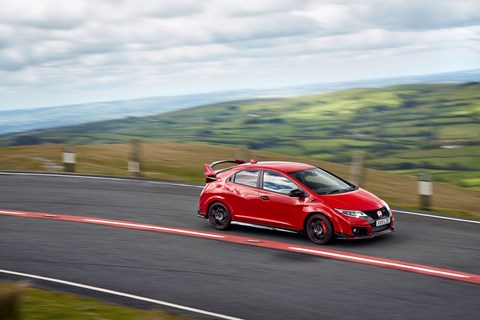
It’s worth addressing the dogma that has prevailed at Honda for decades first though: for all its force this Type R is not a wailing, naturally-aspirated engine of old. The all-new unit doesn’t have that spine-tingling high-end scream, offering up a more perfunctory roar and some lag low down, although it is accompanied, after 3000rpm, by the constant whoosh of the turbo under acceleration and wastegate chirp off-throttle.
Two extremes of the hot hatch spectrum: Golf GTI and Megane Trophy-R
Of course, anyone on a quest requires companions for the road, and the Megane Renaultsport 275 Trophy-R and Volkswagen Golf GTI make pretty good travelling fellows. The Megane is fully tricked out and pitched at the far end of the spectrum: 271bhp 2.0-litre turbo four, PerfoHub double-axis front suspension, Allevard composite front springs, Akrapovic titanium exhaust and Nürburgring Record Pack (to which the marketeers still gamely cling, despite the Type R now holding the crown), which includes bigger 350mm front discs and six-point Sabelt harnesses. The result is a car costing £38,445, an exercise in brutal reduction, a mad monk shorn of worldly chattels, all for the goal of going fast. The Golf is the steadfast, dependable one, with a more sensible 227bhp, despite the addition of the Performance pack – extra power, larger front brakes, ventilated rear brake discs and limited-slip differential, but still a smidge over £30,000. The Civic Type R (in this GT spec) sits between them in terms of price, at a not-inconsiderable £32,295 and Honda claims it is a racer for the road. Wasn’t there a time, not so long ago, when this sort of thing cost ten grand less? For a hot hatch to demand the same investment as an executive saloon, it’s going to have to be pretty special. Certainly the Civic looks a bit special. My first impression of it was that it was cool, all touring car aero mods (claimed to be working, not just for show), huge flicked Samurai helmet rear wing, angular wheelarches and wide front overhang hoovering up the road.
My second impression, following along rather too soon after the first one, was that people were going to see me in it. Let’s be honest here: it is not going to be to everyone’s taste, and it might not be to many peoples’ taste at all. In many ways, it has the character of a throwback, raging against the passage of time, back to when Honda was great and people wore shell suits, had curtain hair, Gazza scored wonder goals, and Max Power readers incorrectly donned baseball caps. It may well be an approach that doesn’t chime with the modern buyer – and certainly one who is old and wise enough to have 30 grand spare.
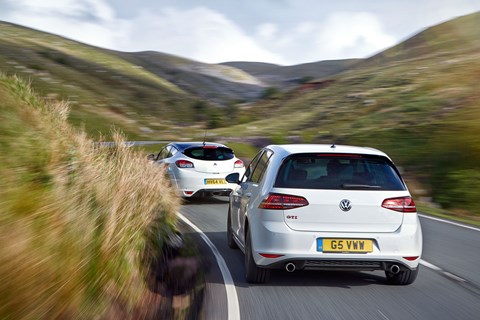
The Golf is so much more of the zeitgeist: centre-conservative, mid-management with delusions of grandeur ubiquity, never likely to offend, offering a glimpse of a cock-tease GTI badge or sharp-edged alloy, but keeping everything corporately homogenous, perfect for matching to an iPhone and designer shopping village suit.
Oddly, the Megane has always been the wilfully outrageous offering in the hot-hatch stable but now, next to the Civic, it seems what it is: a Megane with some red alloys and lots of stickers. Take those transfers off, give it less garish wheels and other than the front splitter it’s a fairly undemonstrative blob. That probably says more about the Honda than it does the Renault.
The best all-rounders
But styling is only a small part of the narrative. This is a fight to be the One True Hot Hatch, the deity on the mountain to which all others aspire, and plenty will soon try to beat. This means it has to be fast and bring glee in those moments of rare abandon, while being adaptable to conditions and lifestyle.
This iteration of the Golf is a master of doing everything well. It may not be the most powerful, but the meaty chug and change-up burp is very satisfying and the click of DSG paddle-change requires as much thought as plipping the lid off a fizzy pop bottle.
Just as well really, because the Volkswagen needs all the picnicky delights it can muster, as the other two will be off snarling in the distance while it cruises along in its merry way.
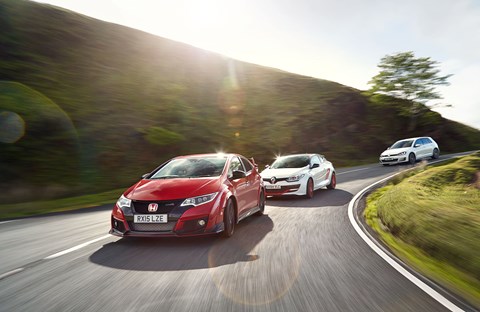
Rarely can a car as accomplished to drive as the GTI have been so outclassed by two rivals. I followed the Civic at one point, darting round bends, and the Golf seed and sawed its way in its wide, four-exhaust wake. There’s just none of the immediate reaction of the other two. The steering has a light little dalliance with the initial turn, which becomes heavier as the car starts to move. Then as the body rolls, there’s a nudge of understeer, which even the diff can’t help, requiring more wheel turn before it settles again. By this point the Civic has, in the technical parlance, buggered off.
That’s because the Civic is just wonderfully controlled, even on scraggy Brecon B-roads filled with the threat of the most stupid sheep on the planet taking a death plunge at you – and they have some stiff competition. Its adaptive dampers work beautifully, giving the suspension the ability to react and manage all conditions.
Like all good sportsmen, it has time in even the most frantic moments. It never feels like it is floating over a crest or still hunkered into a dip as you’re already on the way out. And that allows it to deploy all that power too, because the tyres are always so evenly in contact with the road. Even on some of the more skittery parts of the Black Mountain, uphill, turning out of slow, damp corners, the bespoke Continental tyres in combination with the diff could haul the Civic out with little fuss and barely any intervention from the traction control. Understeer is non-existent if you treat a corner properly.
Straight-line speed
While the Golf can’t get close to the Civic in a straight or curved line, the Megane is hot on its tail. It is a far more extreme machine than the other two, requiring some careful husbandry when the brakes and tyres are cold, and full-on concentration when it’s hot. The gear ratios are much shorter – third is done and dusted nearly 10mph lower in the early seventies – which means that acceleration is more manic.
Jet engine white noise smashes around the cabin while every tink, tonk, bink, bonk and clank rattles through your head from that viciously stiff suspension and bare metal body as you grab a gear before the rapidly approaching limit. Peak power is 800rpm lower than the Civic, while the biggest spoonful of its 265lb ft of torque, is marginally less than the Civic and sighted 500rpm up the rev range too. The result is that it doesn’t have the spread of available easy speed of the Type R and the engine doesn’t want to rev as willingly either. But thanks to its kerb weight of less than 1300kg, a full person less than the Honda, it will keep up with it, if you drive it well.
And that’s the thing with the Megane. It is a brilliant, hairy, lairy thing when driven flat-out, and as much fun as the Civic. Both have front suspension tricks which decouple the steering inputs from the damping, alongside the diffs, and they very successfully negate torque steer for the most part, even with such bonkers power levels trying to escape through the front wheels. The Renault has more communicative steering than the Civic too, which is very quick and consistent, but lacking the nibbly chat of the Megane. But it’s all or nothing in the Trophy-R: slow-moving industrial machinery or fast-moving thing of great joy. The Civic is more nuanced.
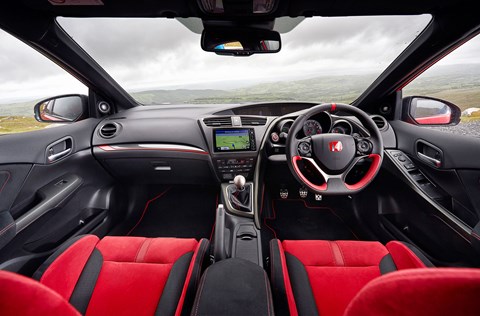
Where the Golf scores is the cabin, which is a lovely place to be, if a little monochromatic: the only flashes of colour are the red stitching on the steering wheel, gearlever gaiter and the hot bit of the air-con dial. Which shows how drab it is, when you notice that.
Unlike the Honda, which is kitted out like Michael Jackson from Thriller, in a riot of scarlet and black. The cabin is Honda’s usual schizophrenic mix of conflicting, jarring angles, oddly scalloped surfaces, and weirdly matching materials, among which are scattered various screens, each fighting for your attention.
So much do they fight that they can even display the same thing. I think I got trip information on three of them at once, while at least two can do radio stations and settings. Only one can offer childish G-force levels, recorded 0-60mph times and laps, though. This is my favourite screen, although I lost this information, never to be found again, somewhere behind a list of DAB stations and a clock graphic designed on a Commodore 64.
Also, the crash-detection system is comically paranoid. It screams that everybody is going to die as you come barrelling up behind traffic, surprised every time by the car’s pace and not remotely aware of the Brembo brakes’ superb slowing power. Was it supposed to have been fitted to a Motability Jazz, but got strapped on the front here by mistake? Poor thing, it will end up having a nervous breakdown.
Inside the Megane’s cabin
No such aesthetic chaos in the Megane’s cabin, which has a dashboard and a speedo. This one actually had a screen for a sat-nav, but it seemed so indulgent and frivolous to the grand scheme of the thing I refused to acknowledge its existence. The steering wheel, thickly rimmed and clad in racy alcantara has a big, workmanlike central boss from a Renault shopping car, which slightly spoils the effect, while the gearknob is also from said urban trolley and doesn’t have the special, milled feel of the Type R’s. But the seats are magnificent deep buckets that look like a machine for mad people in a Victorian sanatorium but hug like your mother.
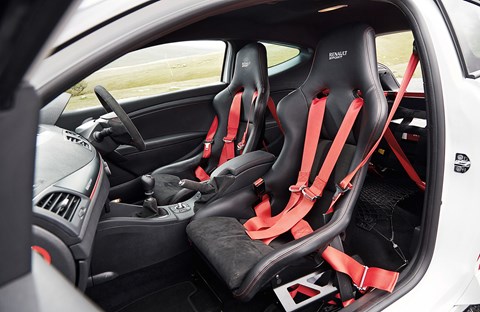
But the things that matter in the Civic are perfect: small, chunky steering wheel, deep seats that are trimmed in suede which feels half an inch thick, and a little aluminium ball for a gearstick. All it requires to go from one to another is a conductor’s fine motor-skilled twitch, balanced nicely against a firm but not heavy clutch. I’m not a bluff old traditionalist, but this old-school charm; the heat from the transmission soaking through the lever as it got worked ever harder, was a joy. I kept moving it endlessly just for the act of doing it. The DSG in the Golf feels anodyne and joyless in comparison.
Perhaps, I thought, the R button in the Civic would see it stretch away from the Megane, a magical potion stiffening the dampers, reducing power assistance and making throttle response more keen. But the steering just felt heavier and more lifeless. I switched it off, perhaps one day to try it on track. It’s just fine in its lighter mood.
That’s the thing with the Civic: it has a lightness to it that the Japanese on their best day can do. And after two days on the Black Mountain, everything is clear. The Megane pushes the Type R close at the very edges, but is nowhere the rest of the time, being just too brutal, while the Golf is comfortable and safe and homely. One is the attack dog, the other the pack donkey.
Verdict
One of the Civic’s great talents is to be both. It feels like a modern Type R should, a great Honda: finely engineered, with a delicacy to its actions and control weights, a fizz to its engine and it is a fabulous machine to drive really fast, or quite hard, or just gently. All that gumpf about the garish-looking aero ticks helping I will happily swallow and put up with, because this is a car that works on its own terms rather than the crushing Germanic premium plan every other car maker is too terrified to break away from, unashamedly following it own path to the summit of the Black Mountain. A new Japanese legend is born.
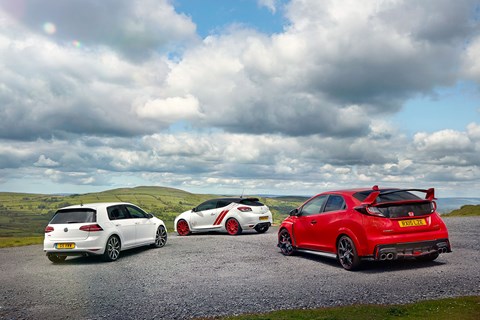
Read on for CAR magazine’s technical spec analysis of the three hot hatches.
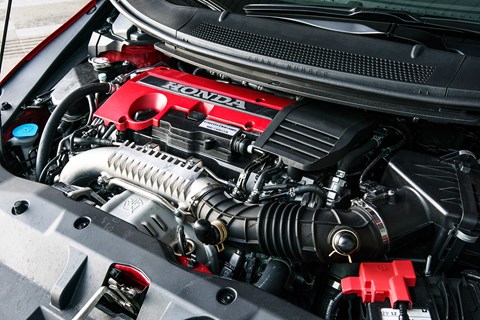
Key tech: Honda Type R goes turbo
In a world where twin-scroll and variable geometry turbos are increasingly common, the mono-scroll turbo fitted to the Type R’s bespoke 2.0-litre seems outmoded. To get round this, Honda has cunningly repurposed its VTEC variable valve timing and lift technology to increase the exhaust pressure at low rpm to reduce lag, and fitted an electronically controlled wastegate to manage induction pressure. With aluminium pistons, aluminium rocker arms, forged conrods and a lightweight crankshaft, the result is an engine that loves to rev – even if the 7000rpm redline is not Honda’s loudest screamer.
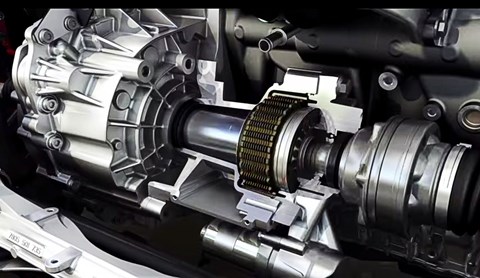
Key tech: The Golf’s Vorsprung durch VAQ
Okay, okay, wrong VW Group brand. But the Vorderachsquersperre (literally: ‘front axle differential lock’) that comes with the GTI Performance Pack – and on other high-performance VW Group products – does deliver progress. Like the conventional limited-slip diffs fitted to the Honda and Renault, it transfers torque to the driven front wheel with the most traction, typically the one on the outside of the corner. But instead of cogs and gears, VAQ uses hydraulics and a multi-plate clutch, giving it a fully variable action that also minimises steering corruption. Very much in keeping with the Golf’s mantra of making life easy for the driver.
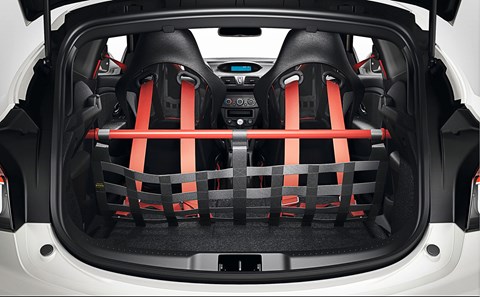
Key tech: Renault’s strip tease
The Trophy-R may look like a boggo Megane victimised by a paint bomb, but it hides many an exotic secret. Öhlins adjustable dampers, Allevard composite front springs and an Akrapovic exhaust all contribute to its 7:54 ’Ring lap and a 1297kg kerbweight that’s 97kg lower than the regular Renaultsport model. Big savers are the Recaro front seats (-22kg), and the deletion of rear seats (-20kg) and much sound deadening (-18kg). Spec the lithium ion battery and upgraded brakes to save a further 20.5kg.